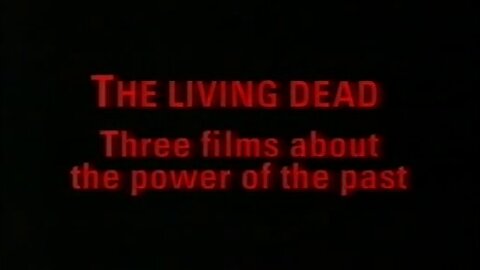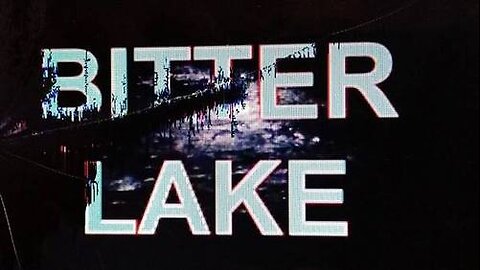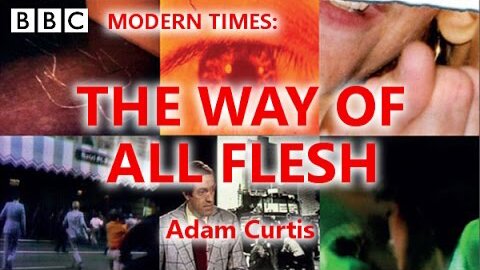
-
Adam Curtis | The Living Dead: Three Films About the Power of the Past | (1995)
 ChaunceysGardenAdam Curtis playlists: Miscellaneous https://rumble.com/playlists/H5NqdFg4G4U Can't Get You Out Of My Head | (2021) https://rumble.com/playlists/dfM0eugWsFI All Watched Over by Machines of Loving Grace | (2011) https://rumble.com/playlists/UEeqeUNA5tM The Trap - What Happened to Our Dream of Freedom | (2007) https://rumble.com/playlists/F9hYmAMJPNM Russia 1985-1999 TraumaZone | (2022) https://rumble.com/playlists/I12Kd8gTf8A The Living Dead: Three Films About the Power of the Pastis the second majorBBCtelevisiondocumentaryseries by British filmmakerAdam Curtis. It was originally broadcast onBBC Twoin 1995. In the series, Curtis examines the different ways that history and memory (both national and individual) have been used and manipulated by politicians and others. Part 1. "On the Desperate Edge of Now" This episode, broadcast on 30 May 1995, examines how the various national ideals and memories of theSecond World Warwere effectively buried, rewritten and manipulated in theCold Warera, only to violently resurface later with events such as theprotests of 1968, the emergence of theRed Army Faction, and the turmoil of theYugoslav Wars. For Germany, this process began at theNuremberg Trials, where the use of the filmThe Nazi Planwas intended to reveal the criminality of the Nazi state, and attempts were made to prevent defendants—principallyHermann Göring—from providing any rational or contextualized argument for their actions during the war. Subsequently, however, bringing lower-ranking Nazis to justice was all but forgotten in the interests of maintainingWest Germanyas an important new ally in the Cold War. Forthe Allies, faced with a new enemy in theSoviet Union, there was a need to portray World War II as a crusade of pure good against pure evil, even if this meant creating a mismatch by denying the memories of the individual soldiers who had actually done the fighting and knew it to have been far more ambiguous. The title of this episode comes from a veteran's description of the uncertainty of survival in combat. A number of American veterans related how, years later, they found themselves plagued with previously suppressed memories of the brutal things they had seen and done. Part 2. "You Have Used Me as a Fish Long Enough" In this episode, broadcast on 6 June 1995, the early history of theCentral Intelligence Agency's (CIA) use ofbrainwashingand mind control is examined. Its thesis is that a search for control over the past, via medical intervention, had to be abandoned, and that in modern times, control over the past is more effectively exercised by the manipulation of history. It concludes that despite successful attempts to remove memories of the past, doing so often left an emotional void that was hard to refill. The angle pursued by Curtis is the way in whichpsychiatry historicallypursuedtabula rasatheories of the mind, initially to set people free from traumatic memories and then later as a potential instrument of societal control. The work ofEwen Cameronis surveyed, with particular reference to the early medical use ofelectroconvulsive therapy, Cold War theories ofcommunistbrainwashing, and the search forhypnoprogammedsleeper agents and assassins. After the intelligence agency failures over theKennedy assassinationand the failedassassination attempts against Fidel Castro, this work was later abandoned in favour of computerised memory and intelligence research, such as theDefense Advanced Research Projects Agency(DARPA), created in 1958. The title of this episode comes from aparanoid schizophrenicseen in archive film in the programme, who believed that her neighbours were using her as a source of amusement by denying her any privacy—like agoldfishin a bowl. Some footage from this episode, an interview with one of Cameron's victims, was later reused by Curtis inThe Century of the Self. Part 3. "The Attic" In this episode, broadcast on 13 June 1995, the national aspirations ofMargaret Thatcherare examined, particularly the way in which she used public sentiment in an attempt to capture the national spirit embodied in the famous speeches and writings of the wartime prime minister,Winston Churchill. Curtis argues that by harking back, or summoning the spirit of Britain's "glorious past", to fulfil short-term political or national ends, the process backfired in the long-run, trapping the invoker in the societal maladies of the present day. The example provided is the wartime levels of patriotism invoked in theFalklands Warcrisis, in which Thatcher's rugged determination matched national sentiment, only to dissipate a few years later with events such as thepoll taxriots, which contributed to her resignation. The title is a reference to the attic flat at the top of10 Downing Streetcreated during Thatcher's refurbishment of the house which did away with the prime minister's old living quarters on the lower floors, replacing them with 18th-century boardrooms. Scenes fromThatcher's premiershipare intercut with scenes from thepsychological horrorfilmThe Innocents (1961), a film adaptation ofHenry James's novellaThe Turn of the Screw.383 views
ChaunceysGardenAdam Curtis playlists: Miscellaneous https://rumble.com/playlists/H5NqdFg4G4U Can't Get You Out Of My Head | (2021) https://rumble.com/playlists/dfM0eugWsFI All Watched Over by Machines of Loving Grace | (2011) https://rumble.com/playlists/UEeqeUNA5tM The Trap - What Happened to Our Dream of Freedom | (2007) https://rumble.com/playlists/F9hYmAMJPNM Russia 1985-1999 TraumaZone | (2022) https://rumble.com/playlists/I12Kd8gTf8A The Living Dead: Three Films About the Power of the Pastis the second majorBBCtelevisiondocumentaryseries by British filmmakerAdam Curtis. It was originally broadcast onBBC Twoin 1995. In the series, Curtis examines the different ways that history and memory (both national and individual) have been used and manipulated by politicians and others. Part 1. "On the Desperate Edge of Now" This episode, broadcast on 30 May 1995, examines how the various national ideals and memories of theSecond World Warwere effectively buried, rewritten and manipulated in theCold Warera, only to violently resurface later with events such as theprotests of 1968, the emergence of theRed Army Faction, and the turmoil of theYugoslav Wars. For Germany, this process began at theNuremberg Trials, where the use of the filmThe Nazi Planwas intended to reveal the criminality of the Nazi state, and attempts were made to prevent defendants—principallyHermann Göring—from providing any rational or contextualized argument for their actions during the war. Subsequently, however, bringing lower-ranking Nazis to justice was all but forgotten in the interests of maintainingWest Germanyas an important new ally in the Cold War. Forthe Allies, faced with a new enemy in theSoviet Union, there was a need to portray World War II as a crusade of pure good against pure evil, even if this meant creating a mismatch by denying the memories of the individual soldiers who had actually done the fighting and knew it to have been far more ambiguous. The title of this episode comes from a veteran's description of the uncertainty of survival in combat. A number of American veterans related how, years later, they found themselves plagued with previously suppressed memories of the brutal things they had seen and done. Part 2. "You Have Used Me as a Fish Long Enough" In this episode, broadcast on 6 June 1995, the early history of theCentral Intelligence Agency's (CIA) use ofbrainwashingand mind control is examined. Its thesis is that a search for control over the past, via medical intervention, had to be abandoned, and that in modern times, control over the past is more effectively exercised by the manipulation of history. It concludes that despite successful attempts to remove memories of the past, doing so often left an emotional void that was hard to refill. The angle pursued by Curtis is the way in whichpsychiatry historicallypursuedtabula rasatheories of the mind, initially to set people free from traumatic memories and then later as a potential instrument of societal control. The work ofEwen Cameronis surveyed, with particular reference to the early medical use ofelectroconvulsive therapy, Cold War theories ofcommunistbrainwashing, and the search forhypnoprogammedsleeper agents and assassins. After the intelligence agency failures over theKennedy assassinationand the failedassassination attempts against Fidel Castro, this work was later abandoned in favour of computerised memory and intelligence research, such as theDefense Advanced Research Projects Agency(DARPA), created in 1958. The title of this episode comes from aparanoid schizophrenicseen in archive film in the programme, who believed that her neighbours were using her as a source of amusement by denying her any privacy—like agoldfishin a bowl. Some footage from this episode, an interview with one of Cameron's victims, was later reused by Curtis inThe Century of the Self. Part 3. "The Attic" In this episode, broadcast on 13 June 1995, the national aspirations ofMargaret Thatcherare examined, particularly the way in which she used public sentiment in an attempt to capture the national spirit embodied in the famous speeches and writings of the wartime prime minister,Winston Churchill. Curtis argues that by harking back, or summoning the spirit of Britain's "glorious past", to fulfil short-term political or national ends, the process backfired in the long-run, trapping the invoker in the societal maladies of the present day. The example provided is the wartime levels of patriotism invoked in theFalklands Warcrisis, in which Thatcher's rugged determination matched national sentiment, only to dissipate a few years later with events such as thepoll taxriots, which contributed to her resignation. The title is a reference to the attic flat at the top of10 Downing Streetcreated during Thatcher's refurbishment of the house which did away with the prime minister's old living quarters on the lower floors, replacing them with 18th-century boardrooms. Scenes fromThatcher's premiershipare intercut with scenes from thepsychological horrorfilmThe Innocents (1961), a film adaptation ofHenry James's novellaThe Turn of the Screw.383 views -
Adam Curtis | HyperNormalisation | (2016)
 ChaunceysGardenAdam Curtis playlists: Miscellaneous https://rumble.com/playlists/H5NqdFg4G4U Can't Get You Out Of My Head | (2021) https://rumble.com/playlists/dfM0eugWsFI All Watched Over by Machines of Loving Grace | (2011) https://rumble.com/playlists/UEeqeUNA5tM Russia 1985-1999 TraumaZone | (2022) https://rumble.com/playlists/I12Kd8gTf8A HyperNormalisation presents a complex narrative of how our world has become increasingly confusing and seemingly out of control. Directed by Adam Curtis, it takes viewers on a journey through the last 40 years of global events, weaving together seemingly disparate threads to create a tapestry of our current reality. The documentary begins in 1975, focusing on New York City and Damascus, and proceeds to unravel a series of interconnected stories that span decades. It covers a wide range of topics, including the rise of financial power, the evolution of suicide bombing in the Middle East, the emergence of the internet and big data, and the growth of the surveillance state. Curtis argues that these events have contributed to a world where politicians, journalists, and ordinary citizens have retreated into a simplified, often fake version of reality. One of the central themes is the concept of “hypernormalisation” itself, borrowed from Alexei Yurchak’s book about the final years of the Soviet Union. This term describes a state where everyone knows the system is failing, but as no one can imagine any alternative, politicians and citizens alike maintain a pretense of a functioning society. Curtis applies this concept to our current global situation, suggesting that we have entered a similar state of cognitive dissonance. The film pays particular attention to the role of political figures and their impact on world events. It highlights how leaders like Ronald Reagan used theatricality over facts in their communications, and how figures such as Colonel Gaddafi and the Assad dynasty in Syria played pivotal roles in shaping Middle Eastern politics. It also touches on more recent political phenomena, including the rise of Donald Trump and the Brexit vote. Curtis’s narrative style is unique and engaging. Rather than relying on traditional talking heads, he uses a vast array of archival footage, repurposed to illustrate his points. This approach creates a visually rich experience that complements the complex ideas being presented. It juxtaposes seemingly unrelated images and events, encouraging viewers to draw connections and see patterns in the chaos of recent history. While HyperNormalisation presents a bleak picture of our current world, it also offers insights into how we arrived at this point. It suggests that the failure of the political left to provide a coherent alternative vision has contributed to the current state of affairs. It also points to the role of technology, particularly social media, in creating echo chambers that reinforce simplified worldviews. The documentary’s scope is ambitious, covering everything from the financialization of the economy to the impact of cybernetics on society. While this breadth can sometimes feel overwhelming, it also provides a comprehensive view of the forces shaping our world. Curtis’s narrative draws connections between these diverse elements, presenting a cohesive, if unsettling, picture of contemporary society. SOURCE: https://watchdocumentaries.com/hypernormalisation/669 views
ChaunceysGardenAdam Curtis playlists: Miscellaneous https://rumble.com/playlists/H5NqdFg4G4U Can't Get You Out Of My Head | (2021) https://rumble.com/playlists/dfM0eugWsFI All Watched Over by Machines of Loving Grace | (2011) https://rumble.com/playlists/UEeqeUNA5tM Russia 1985-1999 TraumaZone | (2022) https://rumble.com/playlists/I12Kd8gTf8A HyperNormalisation presents a complex narrative of how our world has become increasingly confusing and seemingly out of control. Directed by Adam Curtis, it takes viewers on a journey through the last 40 years of global events, weaving together seemingly disparate threads to create a tapestry of our current reality. The documentary begins in 1975, focusing on New York City and Damascus, and proceeds to unravel a series of interconnected stories that span decades. It covers a wide range of topics, including the rise of financial power, the evolution of suicide bombing in the Middle East, the emergence of the internet and big data, and the growth of the surveillance state. Curtis argues that these events have contributed to a world where politicians, journalists, and ordinary citizens have retreated into a simplified, often fake version of reality. One of the central themes is the concept of “hypernormalisation” itself, borrowed from Alexei Yurchak’s book about the final years of the Soviet Union. This term describes a state where everyone knows the system is failing, but as no one can imagine any alternative, politicians and citizens alike maintain a pretense of a functioning society. Curtis applies this concept to our current global situation, suggesting that we have entered a similar state of cognitive dissonance. The film pays particular attention to the role of political figures and their impact on world events. It highlights how leaders like Ronald Reagan used theatricality over facts in their communications, and how figures such as Colonel Gaddafi and the Assad dynasty in Syria played pivotal roles in shaping Middle Eastern politics. It also touches on more recent political phenomena, including the rise of Donald Trump and the Brexit vote. Curtis’s narrative style is unique and engaging. Rather than relying on traditional talking heads, he uses a vast array of archival footage, repurposed to illustrate his points. This approach creates a visually rich experience that complements the complex ideas being presented. It juxtaposes seemingly unrelated images and events, encouraging viewers to draw connections and see patterns in the chaos of recent history. While HyperNormalisation presents a bleak picture of our current world, it also offers insights into how we arrived at this point. It suggests that the failure of the political left to provide a coherent alternative vision has contributed to the current state of affairs. It also points to the role of technology, particularly social media, in creating echo chambers that reinforce simplified worldviews. The documentary’s scope is ambitious, covering everything from the financialization of the economy to the impact of cybernetics on society. While this breadth can sometimes feel overwhelming, it also provides a comprehensive view of the forces shaping our world. Curtis’s narrative draws connections between these diverse elements, presenting a cohesive, if unsettling, picture of contemporary society. SOURCE: https://watchdocumentaries.com/hypernormalisation/669 views -
Adam Curtis | Bitter Lake | (2015)
 ChaunceysGardenAdam Curtis playlists: Miscellaneous https://rumble.com/playlists/H5NqdFg4G4U Can't Get You Out Of My Head | (2021) https://rumble.com/playlists/dfM0eugWsFI All Watched Over by Machines of Loving Grace | (2011) https://rumble.com/playlists/UEeqeUNA5tM Russia 1985-1999 TraumaZone | (2022) https://rumble.com/playlists/I12Kd8gTf8A Bitter Lake presents a complex narrative about the political and historical forces that have shaped Afghanistan and its relationship with the West. Directed by Adam Curtis, it weaves together archival footage, interviews, and historical analysis to create a tapestry of interconnected events spanning decades. The film takes its name from the Great Bitter Lake in Egypt, where U.S. President Franklin D. Roosevelt met with Saudi King Abdulaziz in 1945. This meeting set the stage for a long-standing alliance between the United States and Saudi Arabia, which would have far-reaching consequences for Afghanistan and the broader Middle East. Curtis traces the history of Afghanistan from the 1950s onwards, focusing on the country’s attempts at modernization and the subsequent interventions by foreign powers. The documentary highlights the role of the United States, the Soviet Union, and Saudi Arabia in shaping Afghanistan’s trajectory. It explores how these nations’ competing interests and ideologies contributed to the country’s instability and eventual descent into conflict. The film pays particular attention to the unintended consequences of well-intentioned development projects. For example, it discusses how American-led dam-building efforts in the Helmand Valley inadvertently led to increased opium production, as the altered landscape became ideal for poppy cultivation. This serves as a metaphor for the broader theme of how foreign interventions often produce unexpected and sometimes disastrous results. Bitter Lake also examines the rise of Wahhabism, a conservative Islamic doctrine promoted by Saudi Arabia, and its influence on Afghan society. The documentary argues that the spread of this ideology, combined with Cold War politics and the Soviet invasion, created the conditions for the emergence of militant Islamist groups in Afghanistan. The narrative extends beyond Afghanistan, drawing connections to other global events and conflicts. Curtis suggests that the complex situation in Afghanistan reflects broader trends in international politics, including the decline of grand political narratives and the increasing influence of financial institutions on government policy. Throughout the documentary, Curtis challenges simplistic narratives about good versus evil, arguing that reality is far more nuanced and complex. He presents Afghanistan as a place where different worldviews and ideologies have clashed, often with devastating consequences for the Afghan people. SOURCE: https://watchdocumentaries.com/bitter-lake/414 views
ChaunceysGardenAdam Curtis playlists: Miscellaneous https://rumble.com/playlists/H5NqdFg4G4U Can't Get You Out Of My Head | (2021) https://rumble.com/playlists/dfM0eugWsFI All Watched Over by Machines of Loving Grace | (2011) https://rumble.com/playlists/UEeqeUNA5tM Russia 1985-1999 TraumaZone | (2022) https://rumble.com/playlists/I12Kd8gTf8A Bitter Lake presents a complex narrative about the political and historical forces that have shaped Afghanistan and its relationship with the West. Directed by Adam Curtis, it weaves together archival footage, interviews, and historical analysis to create a tapestry of interconnected events spanning decades. The film takes its name from the Great Bitter Lake in Egypt, where U.S. President Franklin D. Roosevelt met with Saudi King Abdulaziz in 1945. This meeting set the stage for a long-standing alliance between the United States and Saudi Arabia, which would have far-reaching consequences for Afghanistan and the broader Middle East. Curtis traces the history of Afghanistan from the 1950s onwards, focusing on the country’s attempts at modernization and the subsequent interventions by foreign powers. The documentary highlights the role of the United States, the Soviet Union, and Saudi Arabia in shaping Afghanistan’s trajectory. It explores how these nations’ competing interests and ideologies contributed to the country’s instability and eventual descent into conflict. The film pays particular attention to the unintended consequences of well-intentioned development projects. For example, it discusses how American-led dam-building efforts in the Helmand Valley inadvertently led to increased opium production, as the altered landscape became ideal for poppy cultivation. This serves as a metaphor for the broader theme of how foreign interventions often produce unexpected and sometimes disastrous results. Bitter Lake also examines the rise of Wahhabism, a conservative Islamic doctrine promoted by Saudi Arabia, and its influence on Afghan society. The documentary argues that the spread of this ideology, combined with Cold War politics and the Soviet invasion, created the conditions for the emergence of militant Islamist groups in Afghanistan. The narrative extends beyond Afghanistan, drawing connections to other global events and conflicts. Curtis suggests that the complex situation in Afghanistan reflects broader trends in international politics, including the decline of grand political narratives and the increasing influence of financial institutions on government policy. Throughout the documentary, Curtis challenges simplistic narratives about good versus evil, arguing that reality is far more nuanced and complex. He presents Afghanistan as a place where different worldviews and ideologies have clashed, often with devastating consequences for the Afghan people. SOURCE: https://watchdocumentaries.com/bitter-lake/414 views -
Adam Curtis | Inquiry - The Great British Housing Disaster | (1984)
 ChaunceysGardenAdam Curtis playlists: Miscellaneous https://rumble.com/playlists/H5NqdFg4G4U Can't Get You Out Of My Head | (2021) https://rumble.com/playlists/dfM0eugWsFI All Watched Over by Machines of Loving Grace | (2011) https://rumble.com/playlists/UEeqeUNA5tM Russia 1985-1999 TraumaZone | (2022) https://rumble.com/playlists/I12Kd8gTf8A The Great British Housing Disaster is an “Inquiry” film produced by the BBC. It does not feature Curtis’s trademark narration — David Jones does the honors here — nor his surreal use of popular music, but his masterful editing is still on view, as Curtis tells a complex story through an accumulation of interviews and news clips. Also apparent in this film is Curtis’s ire toward the mystifying aspect of bureaucracy, the way power disguises itself behind veils of false complexity so that it can function in the dark. One could call this the Kafkaesque element of Curtis’s social criticism.409 views
ChaunceysGardenAdam Curtis playlists: Miscellaneous https://rumble.com/playlists/H5NqdFg4G4U Can't Get You Out Of My Head | (2021) https://rumble.com/playlists/dfM0eugWsFI All Watched Over by Machines of Loving Grace | (2011) https://rumble.com/playlists/UEeqeUNA5tM Russia 1985-1999 TraumaZone | (2022) https://rumble.com/playlists/I12Kd8gTf8A The Great British Housing Disaster is an “Inquiry” film produced by the BBC. It does not feature Curtis’s trademark narration — David Jones does the honors here — nor his surreal use of popular music, but his masterful editing is still on view, as Curtis tells a complex story through an accumulation of interviews and news clips. Also apparent in this film is Curtis’s ire toward the mystifying aspect of bureaucracy, the way power disguises itself behind veils of false complexity so that it can function in the dark. One could call this the Kafkaesque element of Curtis’s social criticism.409 views -
Adam Curtis | It Felt Like A Kiss | (2009)
 ChaunceysGardenAdam Curtis playlists: Miscellaneous https://rumble.com/playlists/H5NqdFg4G4U Can't Get You Out Of My Head | (2021) https://rumble.com/playlists/dfM0eugWsFI All Watched Over by Machines of Loving Grace | (2011) https://rumble.com/playlists/UEeqeUNA5tM Russia 1985-1999 TraumaZone | (2022) https://rumble.com/playlists/I12Kd8gTf8A It Felt Like a Kiss is Adam Curtis’s psycho-archaeological dig into the mass psychosis that is the American Empire, buoyed by the most jubilant music imaginable.583 views 1 comment
ChaunceysGardenAdam Curtis playlists: Miscellaneous https://rumble.com/playlists/H5NqdFg4G4U Can't Get You Out Of My Head | (2021) https://rumble.com/playlists/dfM0eugWsFI All Watched Over by Machines of Loving Grace | (2011) https://rumble.com/playlists/UEeqeUNA5tM Russia 1985-1999 TraumaZone | (2022) https://rumble.com/playlists/I12Kd8gTf8A It Felt Like a Kiss is Adam Curtis’s psycho-archaeological dig into the mass psychosis that is the American Empire, buoyed by the most jubilant music imaginable.583 views 1 comment -
Adam Curtis | The Way of All Flesh | (1997)
 ChaunceysGardenAdam Curtis playlists: Miscellaneous https://rumble.com/playlists/H5NqdFg4G4U Can't Get You Out Of My Head | (2021) https://rumble.com/playlists/dfM0eugWsFI All Watched Over by Machines of Loving Grace | (2011) https://rumble.com/playlists/UEeqeUNA5tM Russia 1985-1999 TraumaZone | (2022) https://rumble.com/playlists/I12Kd8gTf8A The Way of All Flesh tells the remarkable story of Henrietta Lacks and the profound impact her cells have had on modern medicine. Directed by Adam Curtis, it traces the journey of Lacks, an African American woman who died of cervical cancer in 1951, and the extraordinary legacy of her cells, known as HeLa cells. Before her death, scientists removed cells from Lacks’ body and cultivated them in a laboratory, hoping to find a cure for cancer. What they discovered was astonishing: the cells continued to grow and multiply in ways they couldn’t control. This unique characteristic of the HeLa cells led to numerous breakthroughs in medical research. The film highlights how these cells transformed modern medicine, playing a crucial role in the development of the polio vaccine by Jonas Salk. As demand for the cells skyrocketed, they were put into mass production, becoming an invaluable resource for scientific research. Curtis’s documentary goes beyond the scientific implications, delving into the political and social ramifications of the HeLa cells. It reveals how they became entangled in the politics of the era, influencing the policies of countries and presidents, and even playing a role in the Cold War. The film also sheds light on the ethical considerations surrounding the use of Lacks’ cells. It addresses the fact that her family remained unrecognized for decades, despite the immense contribution of their deceased relative to medical science. This aspect of the story raises important questions about consent, ownership, and recognition in scientific research. Through archival footage and interviews, the documentary paints a complex picture of how one woman’s cells inadvertently shaped the course of modern medicine, while also becoming embroiled in the broader sociopolitical landscape of the 20th century.451 views 3 comments
ChaunceysGardenAdam Curtis playlists: Miscellaneous https://rumble.com/playlists/H5NqdFg4G4U Can't Get You Out Of My Head | (2021) https://rumble.com/playlists/dfM0eugWsFI All Watched Over by Machines of Loving Grace | (2011) https://rumble.com/playlists/UEeqeUNA5tM Russia 1985-1999 TraumaZone | (2022) https://rumble.com/playlists/I12Kd8gTf8A The Way of All Flesh tells the remarkable story of Henrietta Lacks and the profound impact her cells have had on modern medicine. Directed by Adam Curtis, it traces the journey of Lacks, an African American woman who died of cervical cancer in 1951, and the extraordinary legacy of her cells, known as HeLa cells. Before her death, scientists removed cells from Lacks’ body and cultivated them in a laboratory, hoping to find a cure for cancer. What they discovered was astonishing: the cells continued to grow and multiply in ways they couldn’t control. This unique characteristic of the HeLa cells led to numerous breakthroughs in medical research. The film highlights how these cells transformed modern medicine, playing a crucial role in the development of the polio vaccine by Jonas Salk. As demand for the cells skyrocketed, they were put into mass production, becoming an invaluable resource for scientific research. Curtis’s documentary goes beyond the scientific implications, delving into the political and social ramifications of the HeLa cells. It reveals how they became entangled in the politics of the era, influencing the policies of countries and presidents, and even playing a role in the Cold War. The film also sheds light on the ethical considerations surrounding the use of Lacks’ cells. It addresses the fact that her family remained unrecognized for decades, despite the immense contribution of their deceased relative to medical science. This aspect of the story raises important questions about consent, ownership, and recognition in scientific research. Through archival footage and interviews, the documentary paints a complex picture of how one woman’s cells inadvertently shaped the course of modern medicine, while also becoming embroiled in the broader sociopolitical landscape of the 20th century.451 views 3 comments




